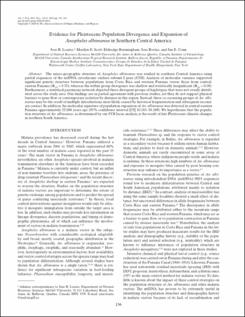Mostrar el registro sencillo del ítem
Evidence for Pleistocene Population Divergence and Expansion of Anopheles albimanus in Southern Central America
| dc.contributor.author | Loaiza, Jose R. | |
| dc.contributor.author | Scott, Marilyn E. | |
| dc.contributor.author | Bermingham, Eldredge | |
| dc.contributor.author | Rovira, Jose | |
| dc.contributor.author | Conn, Jan E. | |
| dc.date.accessioned | 2020-07-10T04:31:16Z | |
| dc.date.available | 2020-07-10T04:31:16Z | |
| dc.date.issued | 2010-01-05 | |
| dc.identifier.other | https://doi.org/10.4269/ajtmh.2010.09-0423 | |
| dc.identifier.uri | http://repositorio-indicasat.org.pa/handle/123456789/200 | |
| dc.description | The micro-geographic structure of Anopheles albimanus was studied in southern Central America using partial sequences of the mtDNA cytochrome oxidase subunit I gene (COI). Analysis of molecular variance supported significant genetic structure between populations from Costa Rica and western Panama versus those from centraleastern Panama (ΦCT = 0.33), whereas the within group divergence was shallow and statistically insignificant (ΦST = 0.08). Furthermore, a statistical parsimony network depicted three divergent groups of haplotypes that were not evenly distributed across the study area. Our findings are in partial agreement with previous studies, yet they do not support physical barriers to gene flow or contemporary isolation by distance in this region. Instead, three co-occurring groups of An. albimanus may be the result of multiple introductions, most likely caused by historical fragmentation and subsequent secondary contact. In addition, the molecular signature of population expansion of An. albimanus was detected in central-eastern Panama approximately 22,000 years ago (95% confidence interval [CI] 10,183–38,169). We hypothesize that the population structure of An. albimanus , as determined by our COI locus analysis, is the result of late Pleistocene climatic changes in northern South America. | en_US |
| dc.description.abstract | The micro-geographic structure of Anopheles albimanus was studied in southern Central America using partial sequences of the mtDNA cytochrome oxidase subunit I gene (COI). Analysis of molecular variance supported significant genetic structure between populations from Costa Rica and western Panama versus those from centraleastern Panama (ΦCT = 0.33), whereas the within group divergence was shallow and statistically insignificant (ΦST = 0.08). Furthermore, a statistical parsimony network depicted three divergent groups of haplotypes that were not evenly distributed across the study area. Our findings are in partial agreement with previous studies, yet they do not support physical barriers to gene flow or contemporary isolation by distance in this region. Instead, three co-occurring groups of An. albimanus may be the result of multiple introductions, most likely caused by historical fragmentation and subsequent secondary contact. In addition, the molecular signature of population expansion of An. albimanus was detected in central-eastern Panama approximately 22,000 years ago (95% confidence interval [CI] 10,183–38,169). We hypothesize that the population structure of An. albimanus , as determined by our COI locus analysis, is the result of late Pleistocene climatic changes in northern South America. | en_US |
| dc.language.iso | eng | en_US |
| dc.rights | info:eu-repo/semantics/openAccess | |
| dc.rights | https://creativecommons.org/licenses/by-nc-sa/4.0/ | |
| dc.subject | Evidence | en_US |
| dc.subject | Pleistocene | en_US |
| dc.subject | Population | en_US |
| dc.subject | Divergence | en_US |
| dc.subject | Expansion of Anopheles albimanus | en_US |
| dc.subject | Southern Central America | en_US |
| dc.title | Evidence for Pleistocene Population Divergence and Expansion of Anopheles albimanus in Southern Central America | en_US |
| dc.type | info:eu-repo/semantics/article | en_US |
| dc.type | info:eu-repo/semantics/publishedVersion |

